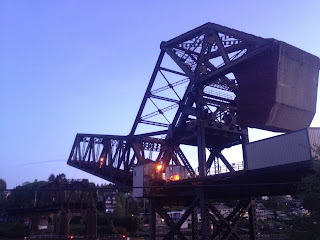Hello drawbridge enthusiasts and/or those with curiosity about drawbridges!
First, a bit about me. I am a 20 year old Civil Engineering student at the University of Washington in beautiful Seattle, Washington, where I have the pleasure of exploring the 9-½ drawbridges located here, in addition to some a little farther out. (What is 'Half' a drawbridge? We'll get to that.) Anyway my current goal in Engineering School is to go on to become a drawbridge engineer. My fantasy goal is to become the preeminent movable bridge engineer in the world, who becomes the international authority on the topic and whom municipalities all over the world come to for advice and consulting. It's a big fish idea, but thankfully, movable bridges are a small pond in the world. It is a very niche market, but I hope to make my mark.
Anyway the first couple of posts are going to give a brief overview of drawbridges and the history, types and functions of the drawbridges in the world, and then continue on to photos of specific examples. Enjoy!
Post 1: The Movable Bridge
 | ||
| Salmon Bay Bridge in Seattle, Wa. |
Anyway the movable bridge evolved into three main types, each with various subtypes to go along, as well as minor types. The three basic bridges are:
The Swing Bridge: Rotate the bridge in a horizontal plane to clear the channel
The Vertical-Lift Bridge: Lift the bridge straight up out of the way of the vessel
The Bascule Bridge: Use a large weight to see-saw the bridge out of the way
With the wonders of autoCAD, I will now attempt to illustrate what is going on.
And here are physical examples of each:
Alright that does it for post 1, over the next couple of posts we will delve into the evolution of each type and the particulars. See you soon!




No comments:
Post a Comment